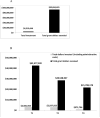Project development teams: a novel mechanism for accelerating translational research
- PMID: 25319172
- PMCID: PMC4280332
- DOI: 10.1097/ACM.0000000000000528
Project development teams: a novel mechanism for accelerating translational research
Abstract
The trend in conducting successful biomedical research is shifting from individual academic labs to coordinated collaborative research teams. Teams of experienced investigators with a wide variety of expertise are now critical for developing and maintaining a successful, productive research program. However, assembling a team whose members have the right expertise requires a great deal of time and many resources. To assist investigators seeking such resources, the Indiana Clinical and Translational Sciences Institute (Indiana CTSI) created the Project Development Teams (PDTs) program to support translational research on and across the Indiana University-Purdue University Indianapolis, Indiana University, Purdue University, and University of Notre Dame campuses. PDTs are multidisciplinary committees of seasoned researchers who assist investigators, at any stage of research, in transforming ideas/hypotheses into well-designed translational research projects. The teams help investigators capitalize on Indiana CTSI resources by providing investigators with, as needed, mentoring and career development; protocol development; pilot funding; institutional review board, regulatory, and/or nursing support; intellectual property support; access to institutional technology; and assistance with biostatistics, bioethics, recruiting participants, data mining, engaging community health, and collaborating with other investigators.Indiana CTSI leaders have analyzed metrics, collected since the inception of the PDT program in 2008 from both investigators and team members, and found evidence strongly suggesting that the highly responsive teams have become an important one-stop venue for facilitating productive interactions between basic and clinical scientists across four campuses, have aided in advancing the careers of junior faculty, and have helped investigators successfully obtain external funds.
Figures

Similar articles
-
Public health emergency accelerated research response-the Clinical and Translational Science Institute of Southeast Wisconsin COVID-19 research initiative.Front Public Health. 2025 May 9;13:1529121. doi: 10.3389/fpubh.2025.1529121. eCollection 2025. Front Public Health. 2025. PMID: 40416685 Free PMC article.
-
The Access Technology Program of the Indiana Clinical Translational Sciences Institute (CTSI): A model to facilitate access to cutting-edge technologies across a state.J Clin Transl Sci. 2020 Aug 19;5(1):e33. doi: 10.1017/cts.2020.525. J Clin Transl Sci. 2020. PMID: 33948256 Free PMC article.
-
Independent investigator incubator (I3): a comprehensive mentorship program to jumpstart productive research careers for junior faculty.BMC Med Educ. 2018 Aug 6;18(1):186. doi: 10.1186/s12909-018-1290-3. BMC Med Educ. 2018. PMID: 30081899 Free PMC article.
-
Access to core facilities and other research resources provided by the Clinical and Translational Science Awards.Clin Transl Sci. 2012 Feb;5(1):78-82. doi: 10.1111/j.1752-8062.2011.00385.x. Epub 2012 Feb 23. Clin Transl Sci. 2012. PMID: 22376262 Free PMC article. Review.
-
Institutional shared resources and translational cancer research.J Transl Med. 2009 Jun 29;7:54. doi: 10.1186/1479-5876-7-54. J Transl Med. 2009. PMID: 19563639 Free PMC article. Review.
Cited by
-
Mentoring in Clinical-Translational Research: A Study of Participants in Master's Degree Programs.Clin Transl Sci. 2015 Dec;8(6):746-53. doi: 10.1111/cts.12343. Epub 2015 Nov 4. Clin Transl Sci. 2015. PMID: 26534872 Free PMC article.
-
Leading by Success: Impact of a Clinical and Translational Research Infrastructure Program to Address Health Inequities.J Racial Ethn Health Disparities. 2016 Oct 28:10.1007/s40615-016-0302-4. doi: 10.1007/s40615-016-0302-4. Online ahead of print. J Racial Ethn Health Disparities. 2016. PMID: 27797013 Free PMC article.
-
Evaluating a CTSA-funded pilot grant program.J Clin Transl Sci. 2020 Nov 16;5(1):e63. doi: 10.1017/cts.2020.557. J Clin Transl Sci. 2020. PMID: 33948283 Free PMC article.
-
The University of Minnesota's Clinical Research Support Center Feasibility Review: An objective protocol assessment carving a pathway to study success.J Res Adm. 2022 Fall;53(2):103-118. J Res Adm. 2022. PMID: 37440894 Free PMC article.
References
-
- Rosenfield PL. The potential of transdisciplinary research for sustaining and extending linkages between the health and social sciences. Social science & medicine. 1992;35:1343–1357. - PubMed
-
- Roberts SF, Fischhoff MA, Sakowski SA, Feldman EL. Perspective: Transforming science into medicine: How clinician-scientists can build bridges across research's “valley of death.”. Academic Medicine. 2012;87:266–270. - PubMed
-
- Denne S, Sajdyk T, Sorkness CA, Drezner MK, Shekhar A. Utilizing pilot funding and other incentives to stimulate interdisciplinary research. In: Alving B, Dai K, Chan SHH, editors. Translational Medicine—What, Why and How: An International Perspective. Vol. 3. Karger; Basel: 2013. pp. 63–73.
-
- Indiana Clinical and Translational Science Institute [September 4, 2014];Homepage. 2012 https://www.indianactsi.org.
Publication types
MeSH terms
Grants and funding
LinkOut - more resources
Full Text Sources

